The Beast’s 5 Horror comics for Halloween
October 31st, 2009

“No more days till Halloween, Halloween, Halloween…”
1) Metropol.
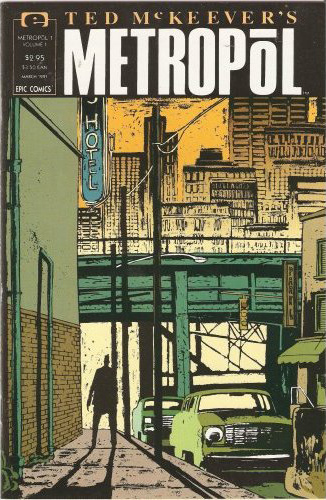
I first encountered Ted McKeever’s unique and brilliant apocalyptic horror story at Gary Lactus’ house years ago. I’d taken a rather heavy dose of mushrooms and in my deranged state picked up a pile of Metropol’s and started reading. The fact that I read them out of order in a heavily altered state didn’t inhibit my appreciation of it in the slightest. In fact I’d thoroughly recommend it.
This heavily claustrophobic vision of a nameless city on the verge of biblical apocalypse is strange, heady stuff. The writing may occasionally verge on the lumpen or purple side, but graphically it’s a masterpiece. McKeever’s blocky, striking style perfectly captures the mood of warped urban horror and Old Testament violence, and he conjures some of the most genuinely weird and unpleasant looking Demons ever committed to paper. The Angels are hardly any better. His city is one of stifling loneliness and ugly, hurting people. The mood of despair throughout is palpable, and as the slow burning conflict between the Angels and the Demons begins to escalate, the visuals of the book warp and twist into strange new territory. Bodies sprout ugly, brutal wings, horns and hooves, the dead return, and a small band of misfits realise that their world is fucked and that no-one’s coming to save them. Unless you count the return of Eddy Current, which as anyone familiar with that character will know, is definitely not a guarantee…
McKeever’s work would never be better than this. Metropol is a unique vision of stark horror from a singular creator.
2) Gyo
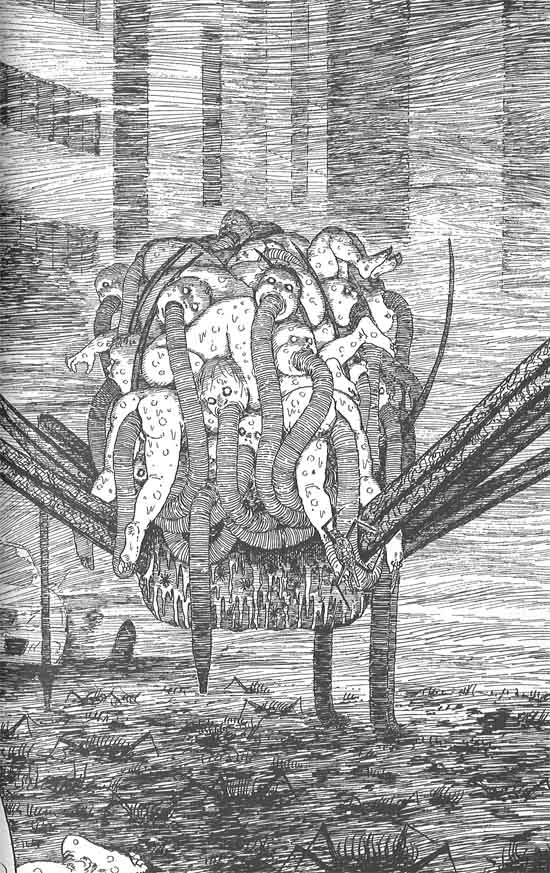
Junji Ito’s Uzumaki is often cited as his signature work, and with good reason. It’s a brilliant vision of a town haunted by a spiral pattern, one that twists minds, bodies, relationships to shocking and disturbing effect. His follow up, Gyo, seems initially a bit of a breeze after Uzumaki’s neo-Lovecraftian weirdness. Seemingly taking it’s cues from Godzilla and a thousand other eco-themed monster stories, it’s core idea of undead sealife that ups and walks right out of the ocean could easily be played for laughs. There’s certainly a rich vein of black humour running through Gyo, but it sure as shit isn’t played for laughs. The sequence where a great white shark on huge insect-like legs menaces the protagonists around a suburban home is a fantastic unholy mash up of Jaws and Halloween, and takes the one consoling factor about sharks – that they can’t get you on dry land – and throws it out the fucking window.
But it isn’t until the second volume that Gyo’s true nastiness is revealed. Ito depicts a strangely believable breakdown of society as a plague of decaying fish lay mindless siege towns and cities. More disturbingly, once the fish decay too far, their parasitic ‘legs’ begin to look for new hosts…
More than any other creator, Ito has found away to update HP Lovecraft and drag him into strange new territory. The idea of ‘reality cancers’ that permeates Lovecraft’s work is taken to the Nth in both Gyo, Uzumaki and earlier work such as the deeply unpleasant viral revenge saga, Tomie. Human bodies are mere fodder to be twisted , warped or used as fuel for malignant, abstract awfulness from beyond our comprehension. Gyo is an intense toxic tale riddled with anxieties of plague and infection, apocalypse and body horror, and the invasion of the truly alien into our reality.
3) Seaguy

For all it’s quirkiness and whimsy my prevailing sensation regarding Morrison and Stewart’s Seaguy is one of genuine unease and creeping dread. It’s part of a noble tradition of distinctly carnivalesque British surreal horror that includes The Prisoner, Monty Python and Doctor Who. Seaguy is ripe with nastiness bubbling below a surface of comedy and farce. It’s undoubtedly a paean to colourful free form superheroics, but it’s also got a real sense of wrongness about it – this is not the world you know. This is a world where torture and mind control experiments happen behind closed doors, while a laughter track drowns at the sound of screaming. Oh wait -that is the world you know…
It’s a comic packed with endless queasy moments – the defilement of the polymorphic wonder that is Xoo, Chubby’s lonely death, and the ongoing soul-crushing of Doc Hero. Morrison’s childlike script and Stewart’s perfect cartooning only heighten the sense of uncertainty. Seaguy is a bright coloured sweet that tastes of rotten meat when you pop it in your mouth.
4) The Marquis
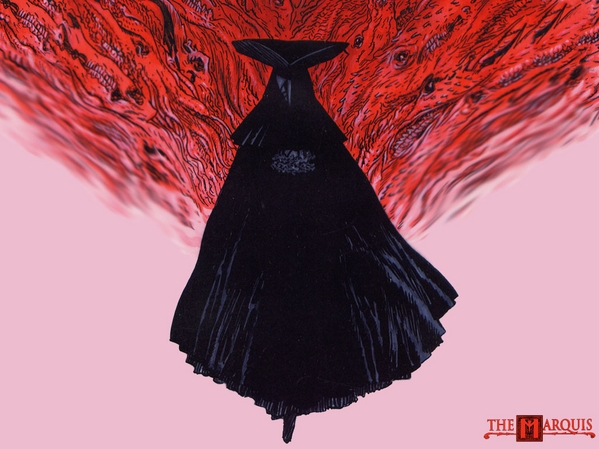
Guy Davis is easily one of the best artists working in American comics today. He churns out page after page of beautiful, loose expressive line work, rendering Jazz-era New York and Lovecraftian beasties with equal aplomb. What came as more of a surprise is that he is an equally capable writer. His own comic the Marquis: Danse Macabre, originally published by Oni, is a stunningly nasty piece of gonzo Gothic. Set in a parallel version of 18th century Venice it details the trials and tribulations of a Church endorsed demon hunter who may or may not be a delusional psychopath. The Marquis is sometimes reminiscent of Milos Forman’s overcooked Amadeus in tone, but has a real bite in it’s portrayal of the real horrors writhing beneath the masks of a decadent society. Davis’ black and white line-work has never looked better, and he creates some fabulous and repellent monstrosities to tax our titular ‘hero’. Grotesque, lumpy, loose skinned things that are strangely reminiscent of Screaming Mad George at his most deranged. They heave, squirm and shudder throughout Davis’ chilly tale. Brilliant stuff.
4) The Blair Witch Chronicles
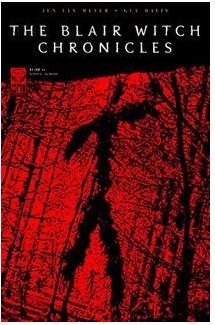
More Guy Davis here. Whilst going through one of my irregular back issue cleanses recently, I came across a couple of tie-in comics that came out around the release of the seminal docu-horror The Blair Witch Project. Film tie-ins are usually some of the shonkiest comics available, but these are pretty classy numbers. More importantly they’re actually pretty fucking scary. One of the most intriguing aspects of the BWP was that it utilised the internet, and supporting material to help build the myth of the Blair Witch into something almost palpable. The sketchy recollections, urban mythologising and use of American folklore built up a genuinely creepy picture of small-town backwoods terror. Even the name seemed vaguely familiar, evoking one of the earliest documented poltergeist cases in American history, the Bell Witch.
The comics add to this composite picture, fleshing put some of the background stories only hinted at in the film (Elly Kedward’s curse, the Rustin Parr killings and most chillingly of all the story of the Coffin rock murders). There’s a danger that realising things only alluded to in the film might dissipate their effectiveness, but the writer Jen Van Meter, and Guy Davis and Bernie Mireault do a stunning job of bringing them to life. They totally nail the eerie vibe of the film, and convey the terrifying, shifting nature of the horrible curse on Burkittsville.
Better yet they conjure an original addition to the mythos in ‘The Kearney Interview’ wherein a 50’s high school prank goes disastrously awry. The woods are a deeply scary place in Burkittsville, and practical jokes have no place in the world of that horrible fucking witch.
If you can find these issues knocking around the back issue bin, pick them up. They’re chilly, skillful little ghost stories, perfect for a quiet Halloween night in.
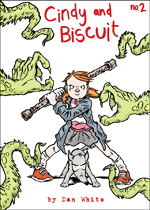



Leave a Reply
You must be logged in to post a comment.